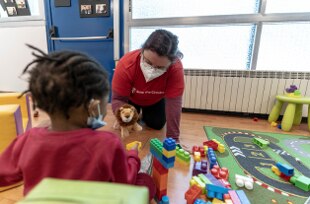Share
July 27, 2021 The victims of trafficking taken care of by the Italian national anti-trafficking system in 2020 were 2,040, of which 716 new cases emerged and taken care of during the year.
These are mainly women and girls (81.8%), 1 in 20 victims is minor (105).
Among the countries of origin of the victims, Nigeria prevails (72.3%), followed by Ivory Coast, Pakistan, Gambia and Morocco.
The most reported form of exploitation is sexual (78.4%), followed by work (13.8%), 1% was involved in illegal economies and 0.6% in begging.
This is what emerges from the report "Little Invisible Slaves" by Save the children.
A particularly alarming element concerns women victims of trafficking and sexual exploitation with minor children, often also in the hands of exploiters and traffickers: the cases of ex-victims or victims with identified children almost doubled between 2016 and 2020, passing from 6% to 11.6% of the total number of cases handled by the anti-trafficking system, with a further increase in the first six months of 2021 (+ 0.4%). Currently, the anti-trafficking system assists 190 vulnerable families including 226 minors.
In the initial phase of the health emergency, starting from March 2020, there was a decrease in the number of reports of new victims of trafficking. The pandemic has made them less evident, visible and traceable, according to the NGO, often unreachable by the identification and protection services. Criminal networks, however, have rapidly intensified the shift of exploitation from the street to indoors, a trend that had already been seen before Covid-19, and boosted online exploitation on the net. Furthermore, according to the testimonies of operators of the anti-trafficking system, we are witnessing a growing multiple exploitation of victims, involved not only in forced prostitution, but also in activities related to illicit economies, as in the case of 'ovulators', which transport to the your body ova drug,or people forced to move around the national territory carrying parcels with them, the contents of which they often do not know. According to the testimonies of the operators, including the partners of Save the Children's Vie d'Uscita project, forced prostitution on the street now concerns mainly trans women and girls or young people from Eastern Europe, who in 2020 accounted for 70 % of the findings of the contact units, 75% from Romania, followed by victims of Albanian and Bulgarian nationality. On the other hand, the number of victims of Nigerian origin, previously very numerous, has been halved, and they are increasingly exploited in connection houses known to customers thanks to word of mouth. Rome, 26 July (LaPresse) - "The pandemic has hindered the work of direct contact and evaluation by anti-trafficking operators, but also the provision of the services of the escape, protection and inclusion paths already started, including training internships and job grants, which, added together to the general economic vulnerability due to the crisis, have exacerbated the real risk of re-trafficking for a large number of young victims ", explains Raffaela Milano, director of Save the Children's Italy-Europe Programs,have increased the real risk of re-trafficking for a large number of young victims ", explains Raffaela Milano, director of Save the Children's Italy-Europe Programs,have increased the real risk of re-trafficking for a large number of young victims ", explains Raffaela Milano, director of Save the Children's Italy-Europe Programs,
"On the contrary, the limitations caused by the pandemic have been promptly transformed into opportunities by the traffickers, who are using technologies and resources of the online network to consolidate a real system of human trafficking digitally. We need to strengthen collaboration. and the exchange of information between all the actors involved, from the police forces to online service providers and non-governmental organizations to respond adequately to this growth in online exploitation ".
As Europol points out, technology has in fact expanded the capacity of criminal networks, acquiring a leading role in all the phases that characterize the trafficking of human beings, both in the countries of origin and in those of transit and destination, making them more strong, pervasive and increasing profits. Encrypted communications and anonymity, no direct intermediation with recruited victims, lower risk of incurring police operations are the elements from which traffickers and exploiters have benefited the most, without forgetting the possibility of monitoring victims through GPS-based location applications . E-trafficking extends from online advertising of victims made available to customers to their recruitment, mostly via social media. They can be 'selected 'by traffickers with virtual hunting methods, hunting, which aim at a certain type of profiles, or lured, with' fishing 'methods, fishing, which most often use false job advertisements to attract economically and socially vulnerable people to be transformed into victims of their business.

